Germany - Sweden
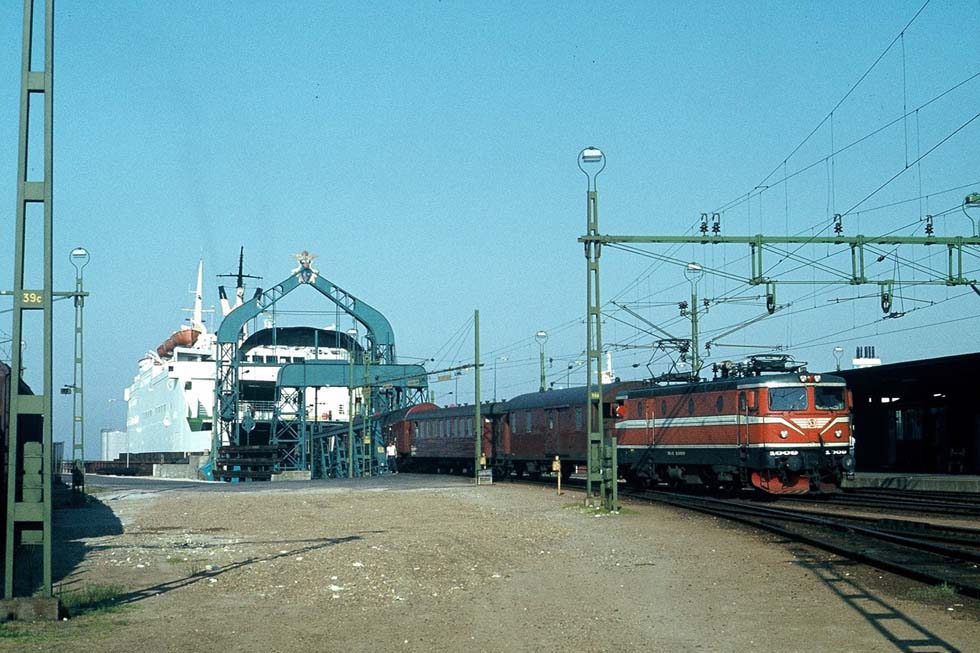
"Skane" of SJ, unloading the Sassnitz-Express Munich - Malmo, Trelleborg 1982 (WS)
The King's Route
First sea communication between the two countries was initiated by the Swedish mail administration in 1763 with fast sailing yachts, which crossed the sea in 24 hours, good wind and weather provided. From 1864 paddle-wheel steamers shortened the passage Stralsund - Ystad to 17 hours. In 1866 Malmo replaced Ystad as the Swedish port of departure. From 1895 bigger and better ships cut the passage to 7 ½ hours, thus making possible a travel from Berlin to Stockholm in 36 hours. A regular passenger service was opened in 1897 between Trelleborg and Sassnitz, then a small fishing port of the German isle of Ruegen. A standard gauge railway, built on Ruegen island, reached Sassnitz in 1897. Trains from Berlin had to be ferried across the Strelasund between Stralsund and the railway station of Altefaehr with the 62m long ferry "Sassnitz", followed in 1898 by the 81m "Puttbus" and in 1902 resp. 1905 by her sisters "Ruegen" and "Bergen", all open-deck single-track twin-screw double-enders.
The successful operation of the Danish Gedser - Warnemuende communication got the Swedish and the German parliaments to think about a train ferry between their countries, too. After lengthy negotiations it was finally opened in 1909 with a great ceremony by King Gustaf of Sweden, hence the name 'Kings' Route'. In accordance with the treaty, Germany and Sweden provided 2 ferries each. In 1909 the "Deutschland" and "Preussen", delivered from Vulcan, and the Swedish "Drottning Victoria", built at Newcastle-on-Tyne, were introduced, followed in 1910 by the "Konung Gustaf V" from Gothenburg yard. They were white-painted twin-screw ships of about 3,500 tons with two funnels. All four were designed for stern-loading, carrying 7 to 8 bogie cars or 16 goods wagons and almost 1,000 passengers. They covered the route of 60 nm in 4 hours at a speed up to 16 knots. Sleeping-cars Berlin-Stockholm and Berlin-Oslo, the latter changed to Hamburg-Oslo, were provided by the Swedish state railways SJ, coaches by the Prussian railway administration.
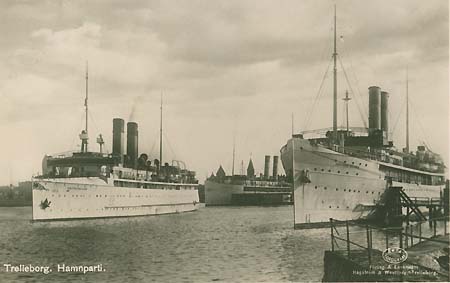
"Deutschland" (left) and "Drottning Victoria" at Trelleborg (old card, coll. WS)
|
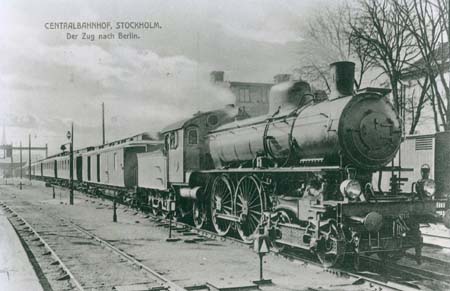
Train for Berlin at Stockholm Central Station before WWI (DB Verkehrsarchiv)
|
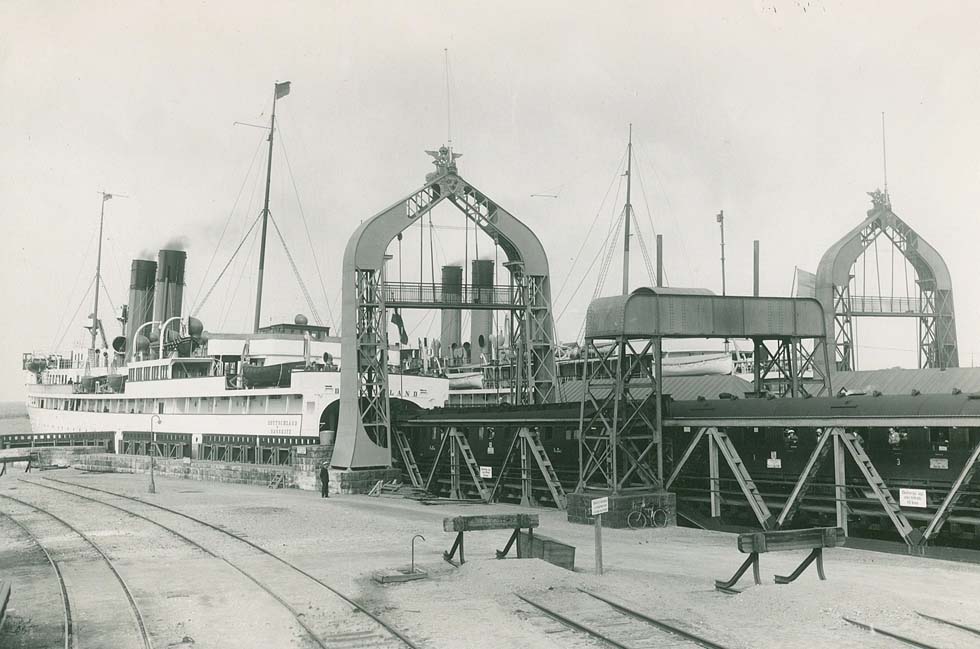
"Deutschland" and the train Stockholm - Berlin, Trelleborg c.1936 (SJ archives)
Between the Wars
During World War I the operation was - after a short interruption - continued with the two Swedish vessels, while the "Deutschland" was equipped as an auxiliary cruiser. During the strong winter of 1924 the port of Trelleborg was blocked by ice barriers of 6 meters thickness. An icebreaker had to work three days to get the passage free again. To cope with such conditions, Swedish State Railways SJ introduced in 1931 the icebreaker-ferry "Starke" of about 8,000 tons with 3 tracks for 21 goods wagons.
Already before WWI there were considerations of replacing the Strelasund ferries by a rail connection. The war prevented it. The DR, the united state railways, introduced a fifth Strelasund ferry, the "Altefaehr". Then the ships were stretched in order to carry five passenger cars, nevertheless the expresses had to be divided. Finally the little boats were replaced by a 2.54 km 'Ruegendamm', consisting of a dyke and two bridges for rail and road traffic, opened on 5th October 1936.
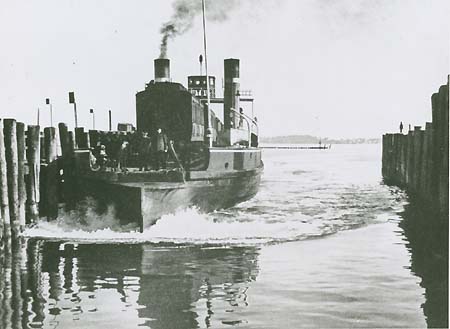
Strelasund ferry "Puttbus" (DB Verkehrsarchiv)
|
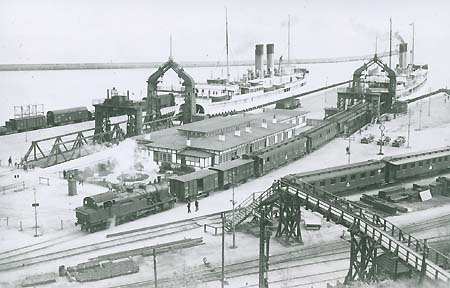
Train with Swedish cars, DR engine 78 006, on the left the "Preussen", Sassnitz before WWII (Carl Bellingrodt)
|
From 1922 a de-Luxe train Skandinavien-Schweiz-Express connected Sassnitz and also Warnemuende with Basle, consisting of sleeping-cars of the new German company Mitropa. Inefficient, it was stopped in 1926, but Mitropa sleeping-cars for Malmo and Swedish sleepers Berlin-Stockholm continued, later joined by a Norwegian sleeper Hamburg - Oslo. Between Berlin and Sassnitz the trains were hauled by tank engines class 78, later also 62 and Pacifics 03.
WWII and Aftermath
During World War II, Sweden stayed neutral and German troops, disarmed, were allowed to pass the country. Even one of the German military expresses SF was listed by the SF timetable of summer 1940 with an itinerary from Narvik in occupied Norway via Sassnitz Berlin, Breslau, Vienna to Villach in Austria, in October 1940 Narvik - Sassnitz - Munich - Innsbruck. According to historian Friedhelm Ernst (to whom we owe much information about all the Baltic connections), ferrying trains across the Baltic Sea was stopped with outbreak of the war. So it must be assumed that the soldiers had to change from train to ship. In winter 1942, when the "Starke" of SJ went to assist the "Konung Gustaf V", she hit a mine and sank. In the same year, the "Deutschland" of DR was torpedoed, but reached the port of Trelleborg. In autumn 1944 the complete shipping route was closed down. The "Deutschland" and "Preussen" were used as supply ships for the German troops in Norway and at last for taking refugees from East Prussia, before being handed over to the Allies. In 1946 they were transferred to the Soviet Pacific coast.
In 1945 the German army blew up the Ruegendamm. As Poland had regained independence after the elimination by the Nazis, it was quite logic that the first post-war ferry route led to Poland. From 25 November 1945 until January 1946 the surviving "Drottning Victoria" provided non-public support services between Trelleborg and Gdansk, the former Danzig. From 25 April 1946 until 20 February 1948 the "Drottning Victoria", "Konung Gustaf V" and the raised and extended "Starke" of SJ were employed on a train ferry service Trelleborg - Gdynia, which included a sleeping car from Stockholm or Gothenburg to Warsaw. From 1947 the Czech timetable listed a 'Balt-Adria-Express' from Gdynia via Gdansk, Wroclav (the former Breslau), Prague and Vienna to Yugoslavia. A CIWL sleeping-car from Gdynia even to Paris was evaluated, to be combined with the Warsaw branch of the Orient-Express, which took another route via Katowice, including cars from Warsaw to Belgrade and to Bucharest for the Arlberg-Orient-Express. The Hungarian timetable of summer 1947 mentioned for this Orient-Express branch even a state-owned sleeper from Stockholm, ferried via Gdynia and ending at the Polish-Czechoslovakian border station Zebrzydowice. According to F. Ernst it took the other route via Wroclav, terminating at the Czech border before being extended in autumn 1947 to Prague, which had been blocked by the CIWL monopoly.
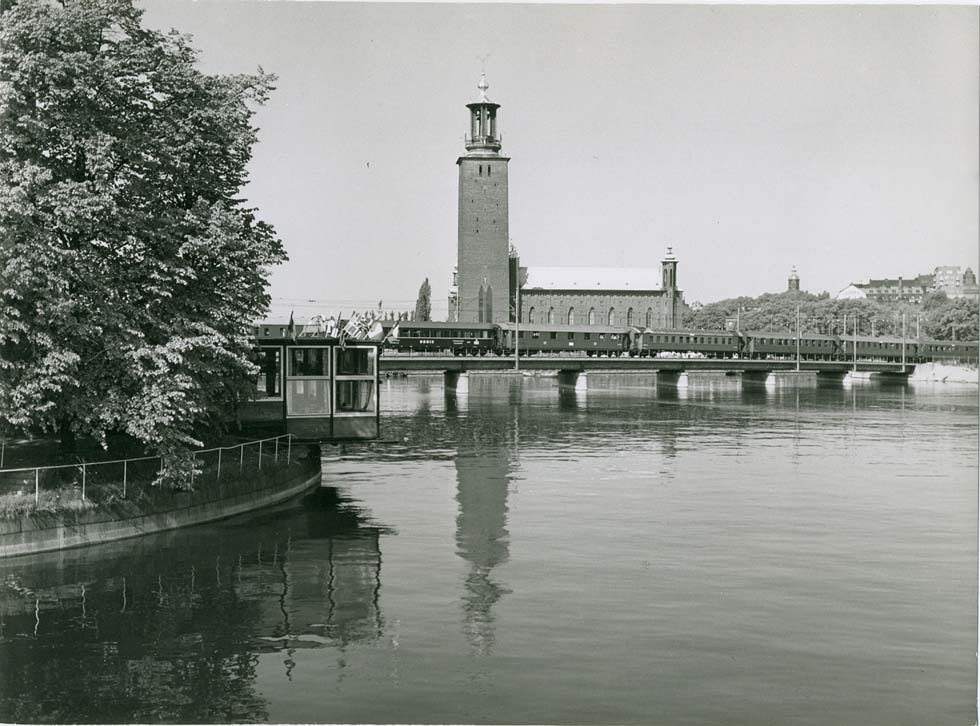
Balt-Orient-Express with a Polish sleeper and Swedish cars, at Stockholm (SJ)
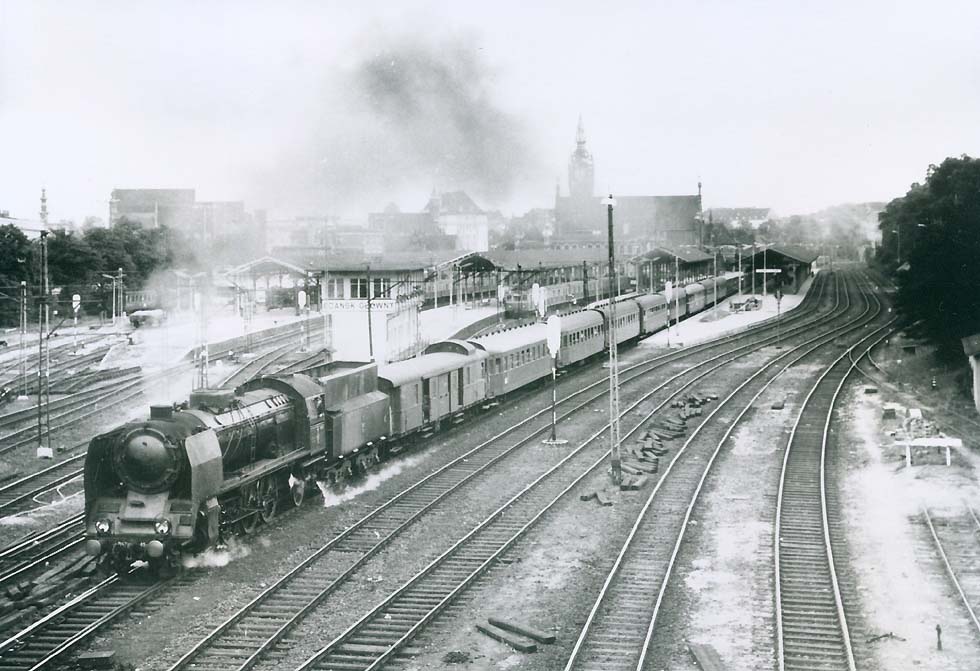
An express with a Pt47 of PKP leaving Gdansk in 1967 (Marc Dahlstrom)
From 20 February 1948 the three SJ ferries changed to a route from Trelleborg to Odra Port, the former Ostswine in the mouth of the river Oder, thus reducing the distance from c.225 nm to 100 nm. In May 1950 the Swedish ferries were joined by the "Kopernik" of Polish state railways PKP, the ex-German "Mecklenburg", handed over by the Soviets. The prestige train for Poland and Eastern Europe should have become the 'Balt-Orient-Express', inaugurated in 1948 via Odra Port, including a SJ sleeper Stockholm - Warsaw, a Polish sleeper Stockholm - Katowice - Budapest - Belgrade, later Sofia, and at least from 1949 a Polish sleeper Oslo - Wroclav - Prague for a 'Balt-Express'. At Odra Port, passengers could also take a through car to Vienna via Katowice. However, as Poland and from 1948 also Czechoslovakia were under stringent Soviet control, traffic did not develop and on 31 December 1953 the Odra Port route was abandoned. Later, Polish train ferries carried only freight trains.
Sweden - Germany
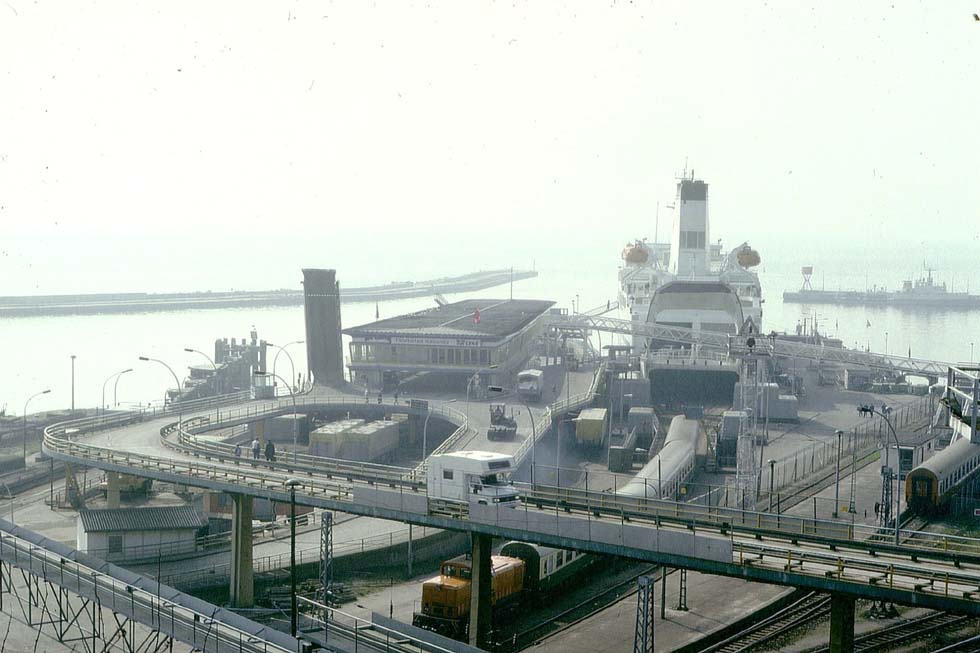
"Sassnitz" of DR and train 'Berlinaren', Sassnitz 1991 (WS)
Winner was the traditional route Sweden - Germany. In June 1947 the SJ ferries restarted it, however on the way Trelleborg - Warnemuende, for the port of Sassnitz had been completely destroyed by Allied air attacks. After repair, SJ changed in 1948 to Sassnitz and a twice-weekly express for Berlin was started. The "Starke" (refitted with a second funnel), the "Konung Gustaf I" and the completely modernized "Drottning Victoria" were converted to oil-burning. However, from October 1952 to August 1953, once again the Trelleborg - Warnemuende route had to be taken, on military reasons, as F. Ernst explained.
With the end of the Oder route, the Balt-Orient-Express, including the sleeper Stockholm - Warsaw, changed on 1st January 1954 to the Sassnitz route. Finally only the Stockholm - Berlin service survived, separated from the Balt-Orient-Express Berlin-Prague-Bucharest. Nevertheless, under CEO Erwin Kramer the East-German DR undertook strong attempts to intensify relations with Scandinavia. A new 'Sassnitz-Express' connected from 1955 the ferry port with Munich, consisting of a pre-war fast diesel railcar set (type Koeln, then type Leipzig), in 1958 replaced by a conventional train, starting at Malmo, later at Stockholm. Due to the political situation however, it served mainly the Berlin traffic, though from 1965 there were Soviet sleepers from Stockholm and from Oslo to Moscow via Berlin and Warsaw. Between Malmo and Berlin the DR started in 1968 the 'Berlinaren' initially a modern VT18.16 Goerlitz railcar set. From 1970 a 'Meridian' ran Malmo-Berlin-Belgrade, 1976-81 extended to Bar on the Adriatic, in Germany hauled mainly by Pacifics (for all these trains see the book 'Internationale Schnellzuege in der DDR', by Rico Bogula).
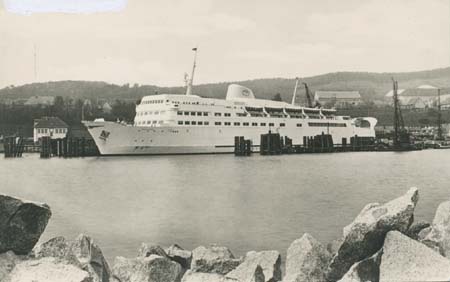
"Trelleborg" of 1958 in Sassnitz (old card, coll. WS)
|
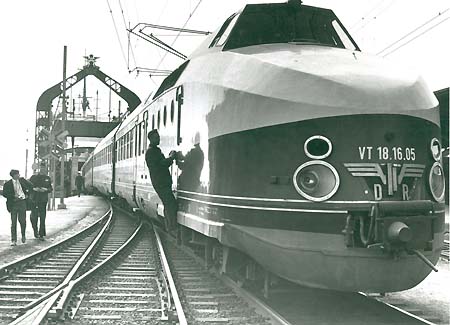
'Berlinaren' of DR, Berlin - Malmo, being unloaded at Trelleborg (SJ archives)
|
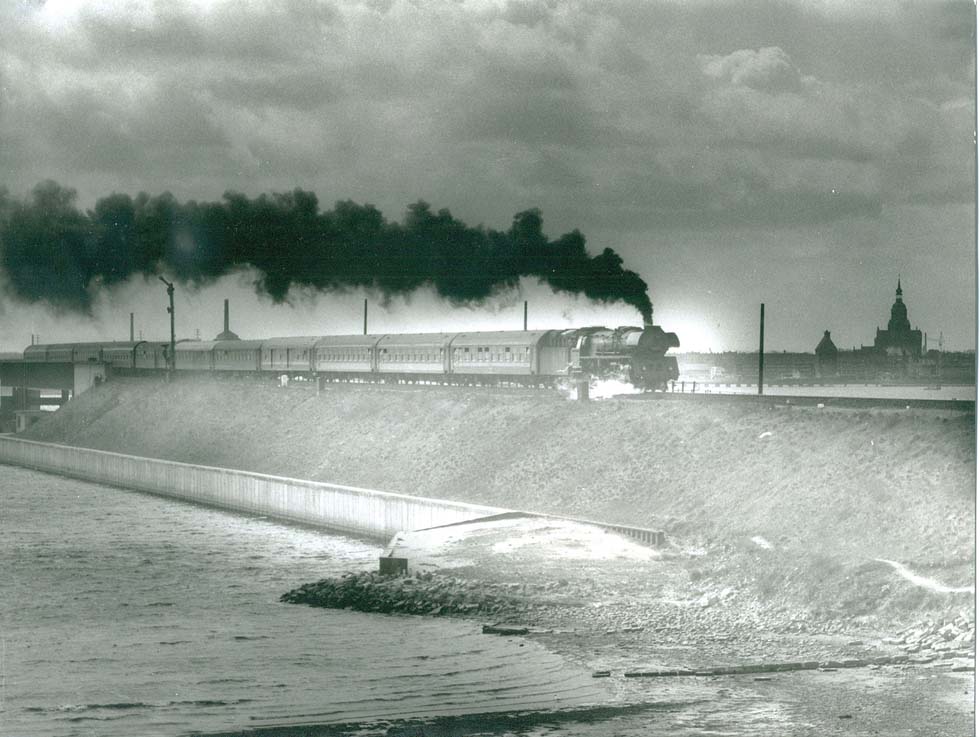
Express 'Meridian' Bar - Malmo with 03.10 of DR, Ruegendamm 1979 (Wolfgang Buegel)
It was not before 1959 that the East German DR could introduce a new ferry "Sassnitz", registered with 6.164 gt, a diesel-powered two-funnel ship with four tracks and additional facilities for car transport. She was followed in 1972 by the "Ruegen", larger, with two parallel funnels different in appearance and with 21 knots faster (the "Rostock" of 1977 was built for freight service). With a gross tonnage of 20,276 and 711 track metres substantially larger, a new "Sassnitz" was put in service in 1988.
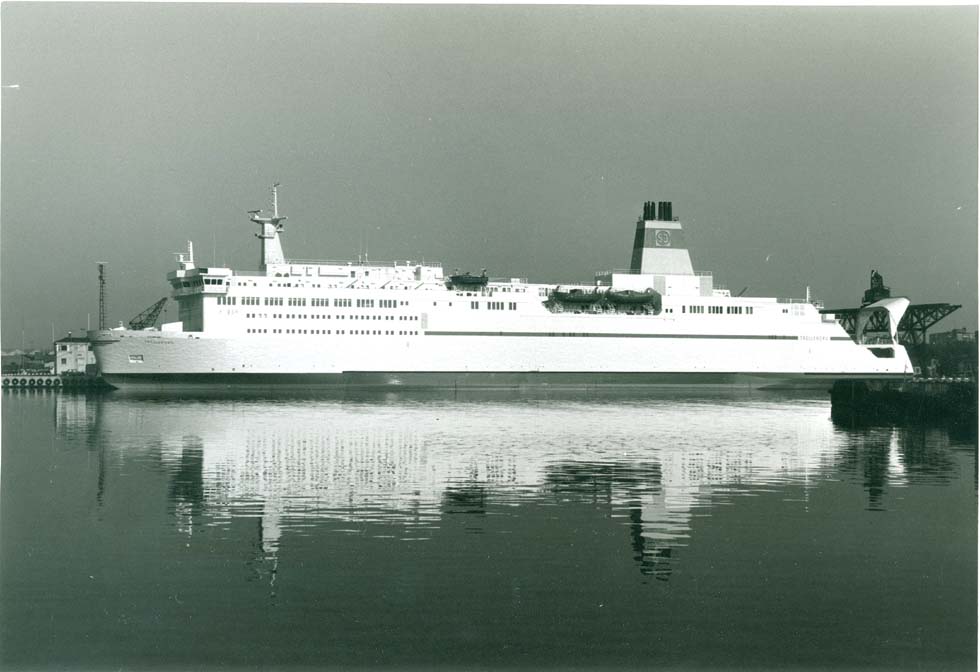
The new "Trelleborg" at Trelleborg in 1982 (WS)
Swedish SJ introduced in 1958 the 6,476-ton four-track "Trelleborg", in 1967 a new "Skane" of c. 7.000 tons and (after two freight ferries) in 1982 a new "Trelleborg", initially registered with 10,882, then 20,228 gt, with 680 track metres. Labelled TS-Line, she was in 1994 transferred to Swe-Ferry, which amalgamated into Scandlines. The "Skane", given away as "Moby King", was scrapped in 2002. With a new 45,705-gt "Skane", Scandlines raised in 1998 the dimensions and introduced her together with the German "Mecklenburg-Vorpommern" between Trelleborg and Rostock (one of the routes not used for conveying passenger trains, together with their ships not described here). The "Sassnitz" was transferred in 1993 to DFO. In November 1995 she got in distress when freight wagons had loosened in a storm. In 1997 she was registered with amalgamated Scandlines, privatized in 2007. The "Ruegen", diverted to Sassnitz - Roenne, was scrapped in 2005.
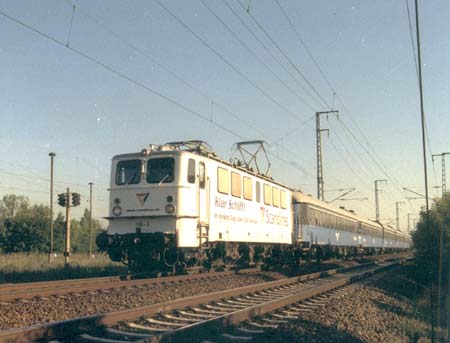 EN Malmo - Berlin at Berlin-Wuhlheide in 2003 (Rico Bogula)
EN Malmo - Berlin at Berlin-Wuhlheide in 2003 (Rico Bogula)
International passenger trains disappeared one by one, but even after the turn of the century the German "Sassnitz" of 1989 and the Swedish "Trelleborg" of 1982 maintained the Scandlines service between Trelleborg and Ruegen for cargo trains, trucks and motorcars. On Ruegen island the ferry port was relocated in 1998 from Sassnitz to Mukran. And, after German railways closed down the last passenger train Malmo - Berlin, a privately-run 'Berlin Night Express' Malmo - Berlin was introduced in 2001, sporting the Scandlines label. Despite several changes and reduction to couchette cars, it continued running through the lovely Uckermark.
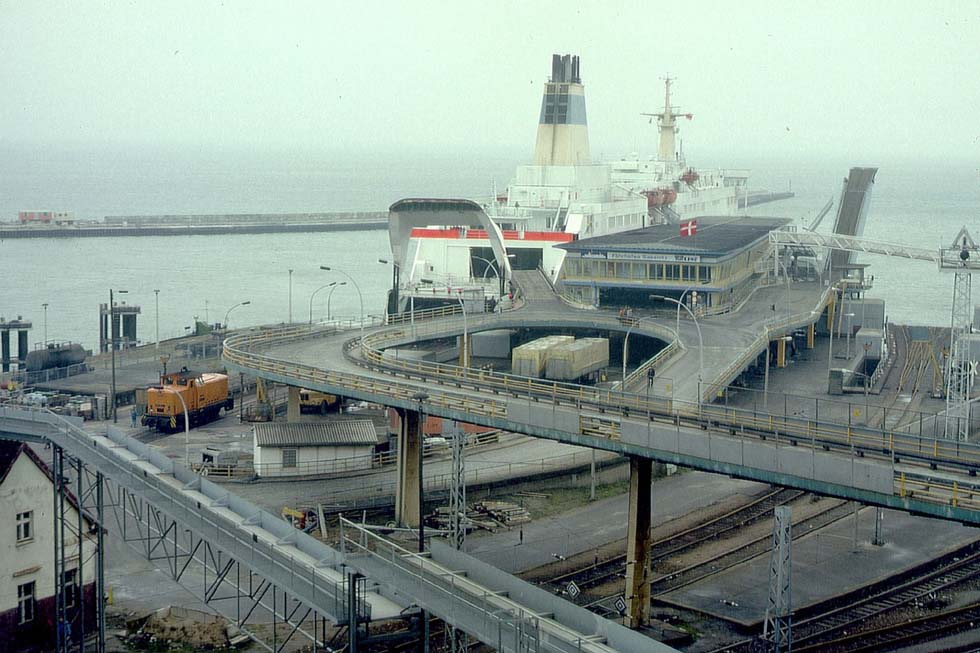
"Trelleborg" after arrival with the 'Berlinaren', Sassnitz 1991 (WS)
|